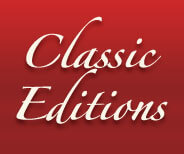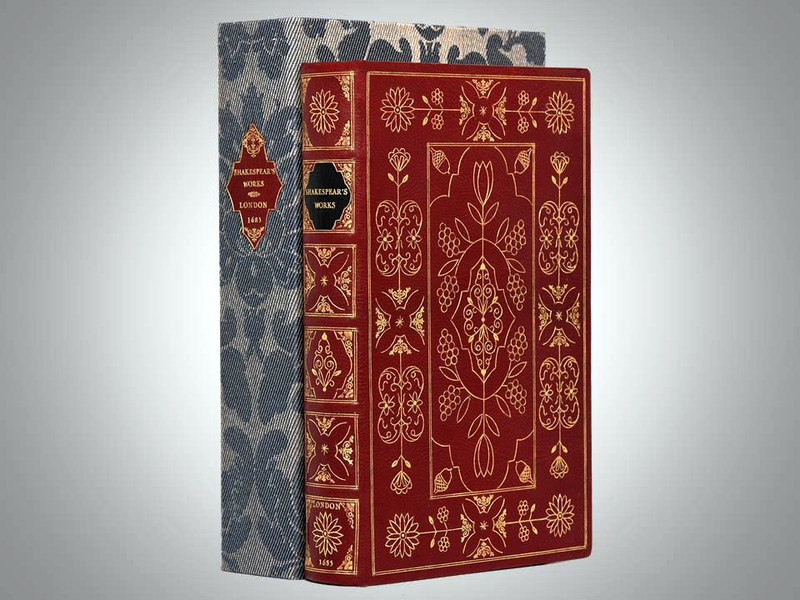Shakespeare's Fourth Folio, 1685, The Roderick Terry Copy, Binding by Jamie Kamph,
- SKU:
- jk4thfolio
Description
Mr. William Shakespear's Comedies, Histories, and Tragedies: The Fourth Folio
Printed for H. Herringman, E. Brewster, and R. Bentley, London in 1685
Provenance: The Roderick Terry and Fox Pointe Collection Copy
Unique Leather Binding by Jamie Kamph, Stonehouse Bindery
Exceptional Condition
Binding Details: Mr. William Shakespear's Comedies, Histories, and Tragedies is a beautiful unique leather binding designed and executed by Jamie Kamph in 2018. The book is bound in full Harmatan dark red goatskin and features and elaborate all-over gold tooling design derived from a period binding of Richard Allesstree’s The Lively Oracles: 1678, included in English Bindings 1490-1940 in the Library of J.R. Abbey, edited by G.D. Hobson, London: The Chiswick Press, 1940. Since the floral tools (tulips, acorns, sunflowers, etc.) used by this 17th century binder were no longer available, Jamie Kamph made up a similar design using small line tools, circle tools, and curved line tools. There are handsewn silk endbands and Payhembury period-style marbled paper pastedowns and flyleaves. The book is housed in a custom made clamshell box that is covered in a luxurious blue/grey damask fabric which would also have been appropriate to the seventeenth century. The box has a title label that repeats one compartment from the spine decoration on the book. The Stonehouse Bindery stamp appears in gold gilt on the inside rear cover.
Included with the book is an artist statement by that contains information about the binding and the conservation work she performed on the book’s internals. Also included is a copy of the Allestree binding and her design pattern with indications of different tools used in the making of the binding.
Book Details: This is the 1685 Fourth Folio of Shakespeare’s plays, first issue, with the engraved frontispiece portrait of Shakespeare by Droeshout, the ten-line poem by Ben Jonson and John Milton’s first poem. The “four folios of Shakespeare” are the first four editions of Shakespeare’s collected plays, which were the only collected editions printed in the 17th century. At that time, plays were not considered “serious literature”; they were to be performed and attended, not read, and thus they were not routinely printed and often survived only in manuscript form. This Fourth Folio “contains the additional seven plays that first appeared in the 1663 [third folio] edition [only one of which, “Pericles, Prince of Tyre,” is now attributed to Shakespeare], as well as a good deal of correction and modernization of the text designed to make it easier to read and understand” (Folger’s Choice 6). It was the last edition of Shakespeare’s plays printed in the 17th century—last to appear before the editorial onslaught of the next hundred years. Because the Fourth Folio had been “modernized,” it was therefore nearer a modern text than either the Second or Third, and became the edition of choice for future editors. Shakespeare’s first acknowledged editor, Nicholas Rowe, for example, used the Fourth as the basis for his famous 1709 edition. The Fourth was printed on Dutch Demy Royal sheets, a larger format than any of its predecessors, and the type “is in a larger font than the three earlier editions, and more liberally spaced” (Jaggard, 497). In addition to Ben Jonson’s famous epitaph, this edition also includes the unsigned “An Epitaph on the admirable Dramatick Poet, William Shakespear,” regarded as John Milton’s first published poem, written when he was a student at Cambridge and appearing for the first time in the Second Folio (1632).
This copy of the Fourth Folio bears the ex-libris plate of Roderick Terry (1849-1933) who collected beautiful and substantial items chosen with considered discrimination. Terry accumulated items in various fields, but his library was especially strong in English literature: he owned the four folios, and he had strong holdings in Byron, Lamb, Spenser, and Milton. He also collected Americana, assembling a complete set of autographs of the signers of the Declaration of Independence, in addition to many literary items. Dickinson characterizes him as "a connoisseur in the grand old tradition of the 19th century. Also included is the ex-libris plate of the Fox Pointe Collection (The Library of Dr. & Mrs. H.R. Knohl who during the late 20th century had amassed the world's largest collection of first-edition English language books printed before the 17th-century. The ex-libris plates of Roderick Terry and The Fox Pointe Collection are laid into the book so the new owner can determine if they want to permanently affix them to the inside of the book or leave them unattached.
About the Artist: Jamie Kamph is an author, educator, book conservator, and artist widely recognized as one of most knowledgeable and accomplished bookbinders in the world. She began her career working with Hope G. Weil before opening her own studio, The Stonehouse Bindery, in 1973. Her writings on bookbinding have been widely published in magazines and she is the author of “A Collectors Guide to Bookbinding, published by in 1982 by the Bird and Bull Press and “Tricks of the Trade: Confessions of a Bookbinder”, published by the Oak Knoll Press in 2015. Her design bindings are housed in private collections and institutions worldwide including Princeton University, The Metropolitan Museum of Art, The Pierpont Morgan Library, the New York Public Library, and the Bridwell Library at the University of Texas. Many of her other bindings have been widely exhibited in such places as the Metropolitan Museum of Art, the Grolier Club, Yale University, and the Aspen Art Institute. In 2003, she was awarded the Helen Ward DeGolyer Award for American Bookbinding.
Condition Report: The binding and clamshell box are in exceptional condition. Internally, the book contains all of the original pages. The Shakespeare folios are notoriously poorly-printed and, because of their popularity and importance, well-handled. As Otness notes: "Most copies of the Shakespeare Folios show considerable wear and have replacement pages. This is particularly true of the title and portrait pages and other introductory leaves... The Folios have been subjected to considerable wear over the years, and ‘perfect’ copies are rare today." Jamie Kamph has done some conservation work on the book to restore it to as “close to perfect” as possible. The following are her comments on work performed, “The book had been bound by Riviere & Sons in red morocco with gold-tooled border and gilt spine. The pages were extremely acid; numerous small rips appeared at the edges; previous paper repairs were coming loose. In the course of removing the existing binding, I found that the original signature configuration had been ignored and clumps of pages oversewn together, then into the book block. This was commonly used to compress the pages so they could be pressed flat, thereby reducing the thickness of the volume but it also prevented the book from opening easily and lying flat when open. After washing and deacidifying the pages, I reestablished the original signature formation, guarding pages together where necessary. I then re-repaired any loose mends and mended any small tears that had not been treated previously. I sewed the signatures together with linen thread around raised linen cords. (The cord formation on the earlier binding was artificial.) I added matching endpapers and Payhembury period –style marbled paper pastedowns and flyleaves.”
Photographs of the binding and clamshell box appear in the photo section of the listing.






